After about a week of play, the Blackhawks have sputtered, starting the season with two losses in three games and falling to 24th in league standings. The team has managed nine goals and surrendered 11, starting the season in uninspiring fashion.
A handful or less of wins, losses and goals isn’t much to go on. Instead, let’s take a look into Chicago’s underlying stats to get an idea of how the team has played and, perhaps, highlight a couple areas of concern or hope as the season begins.
First, a look back at each game:

This chart shows the “shots” differential for Chicago’s home opener — that is, “Corsi,” including all shots on goal, missed shots and blocked shots. Facing off against a tough divisional opponent, the Blackhawks struggled to keep pace. Blues’ depth forwards Kyle Brodziak and Ryan Reaves posted the best differentials (approximately +8 in Corsi differential). David Perron and blue liner Colton Parayko were strong for the Blues as well.
Advertisement
Despite positive showings by Jonathan Toews, Artemi Panarin, Brian Campbell and Marian Hossa, most Blackhawks finished with negative shot differentials. Corsi is a good proxy measure for possession, so Chicago’s poor Corsi differential showing as a team suggests that the group chased the puck all night — not a recipe for success.
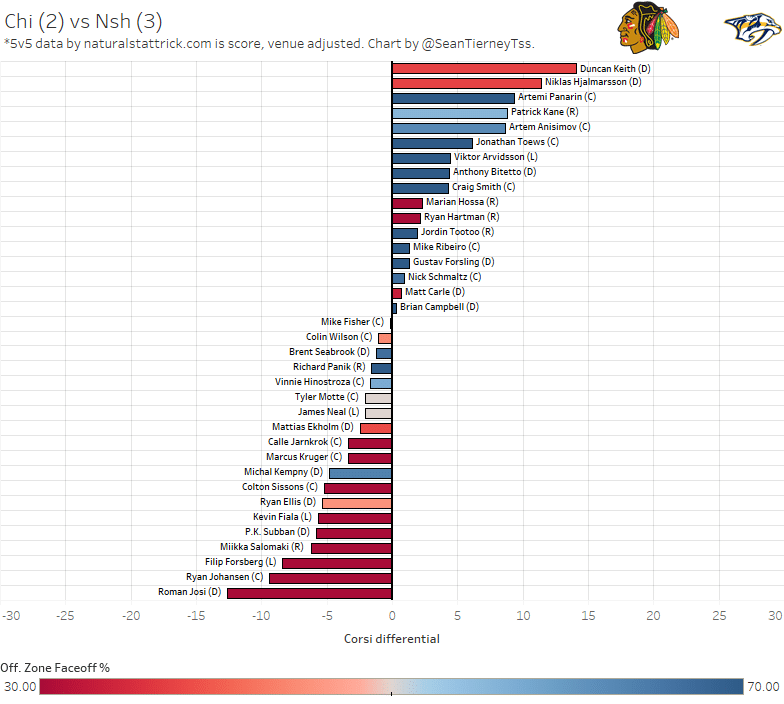
Despite losing their second game, the Blackhawks looked much better against the Nashville Predators. Duncan Keith and Niklas Hjalmarsson posted very strong shot totals during 5-on-5 play and most Chicago skaters finished with positive Corsi differentials.
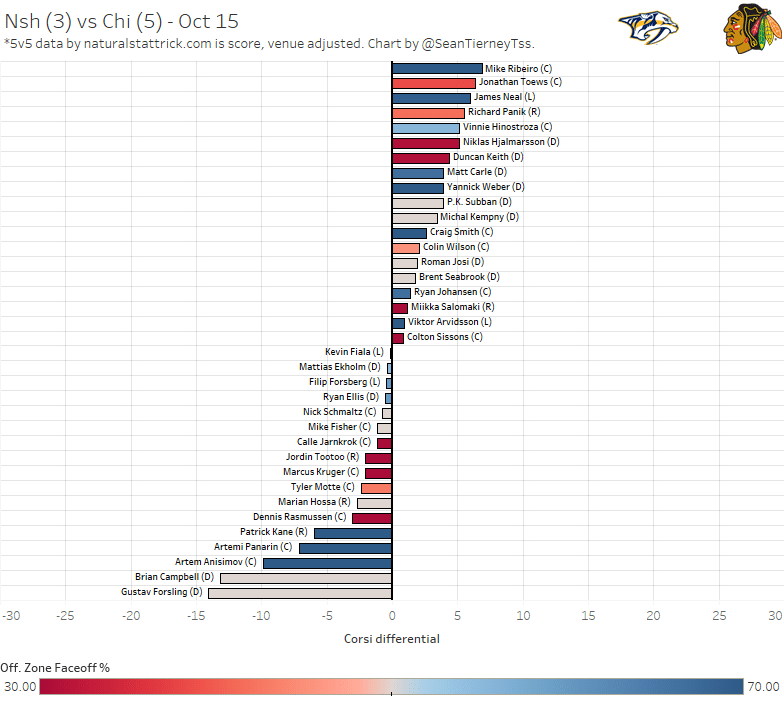
Chicago’s first win of the season was a mixed bag, shots-wise. Toews, Keith and Hjalmarsson landed in their usual positive spots. But the Blackhawks also dominated the bottom of this game chart, including Kane, Panarin, Anisimov, Campbell and Gustav Forsling with particularly poor showings.
It’s worth noting why Corsi is such a useful statistic to track. Corsi predicts future goal differentials better than past goal differentials. Goals lead to wins and Corsi is therefore a useful metric for predicting which teams are likely to win games. For more on the theory, check Garret Hohl’s (editor at Hockey Graphs) primer here.
So, an uneven start for the Blackhawks in terms of Corsi differential demonstrates some reasonable performances, littered with an array of shoddy puck play to start the season.
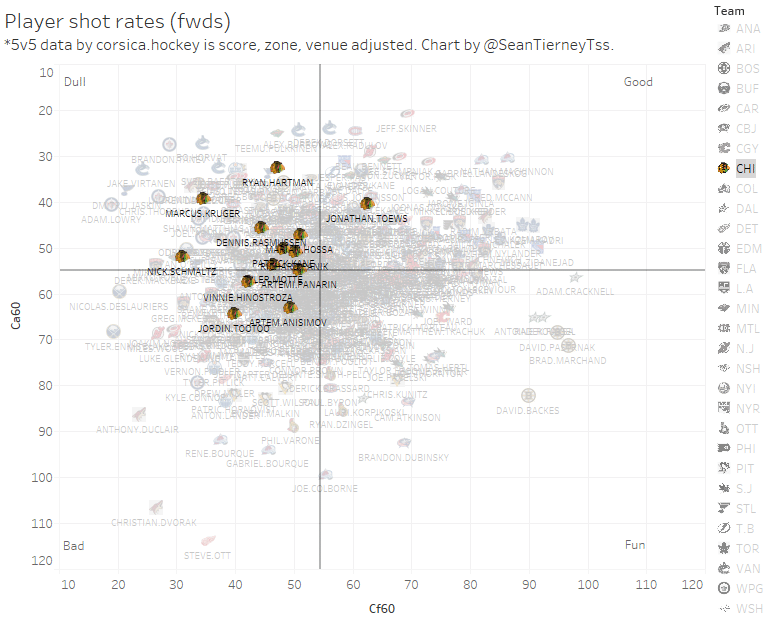
As a companion to the game-level views, this is a look at how the Blackhawks’ forwards have fared in shot rate for and against (Corsi for per 60 minutes versus Corsi against per 60) relative to the rest of the NHL.
So far, so good for Jonathan Toews, the lone Blackhawks skater to post an above NHL-average rate of shots for while maintaining a lower than average rate of shots against while he’s on the ice at even strength. This lands Toews in the “good” quadrant.
Advertisement
For forwards, Toews stands alone.
Interestingly, the remainder of the Blackhawks’ forwards land in the “dull” quadrant here. This reveals that head coach Joel Quennville’s forwards are both attempting and allowing a below league-average rate of shots. Whether this is a deliberate team strategy to play a defensive style or a small sample quirk remains to be seen.
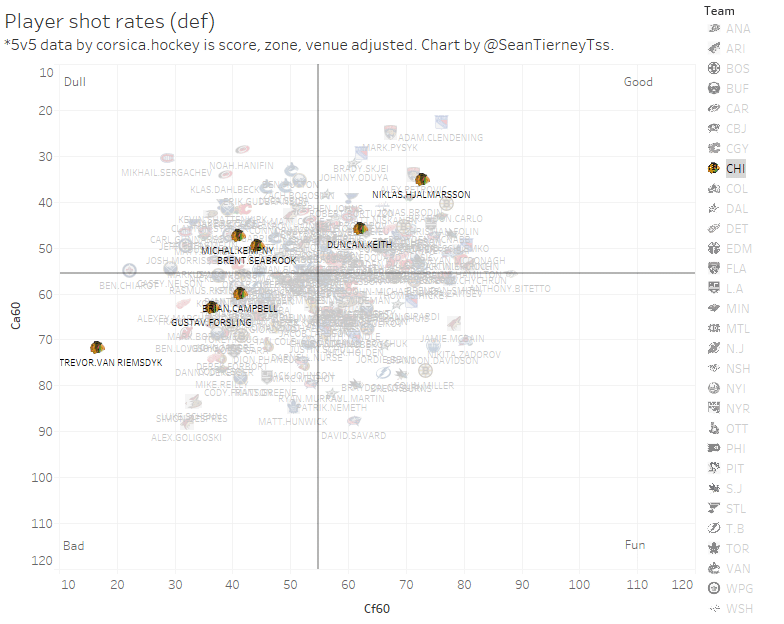
It’s a slightly different story on defense in the early going. Stalwarts Duncan Keith and Hjalmarsson plot in their usual spots. Both defensemen are “good” as they are on-ice for above average shot rates for and below average shot rates against.
The rest of the Blackhawks defense corps has struggled. Michal Kempny and Brent Seabrook are on-ice for below average shooting for and against while Trevor van Riemsdyk, Forsling and Campbell have slipped into the “bad” range.
While Corsi doesn’t tell the whole story, it’s an important piece of the statistical puzzle. For the Blackhawks, the very early player-level results show a team that isn’t playing with much pace and has struggled to dominate possession of the puck. The Blackhawks’ skaters will need to iron out their puck management going forward to avoid taking up a permanent spot near the bottom of the NHL standings.
Finally, let’s take a look at how the Blackhawks compare with the rest of the NHL in a few key advanced metrics.
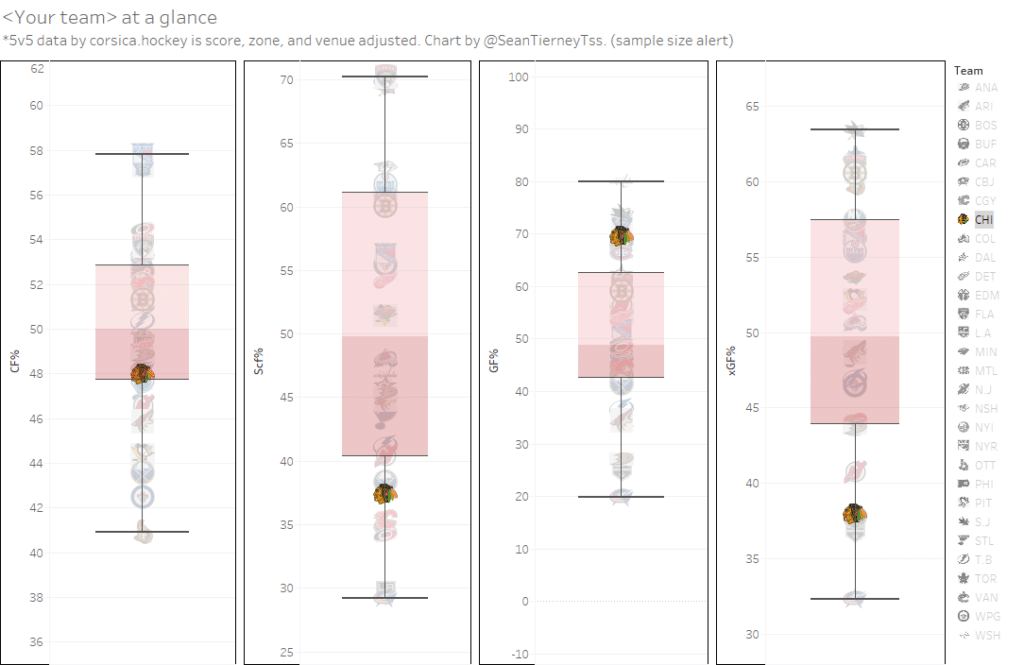
*for the full, interactive view of this chart, click here. For more on the stats themselves, please refer to corsica.hockey.
In this box-and-whisker view, every NHL player is ranked by their performance in four key statistics: CF%, Scoring chance for %, Goals for %,and expected goals for %. The red shaded middle area represents 50 percent of all teams. The bottom “whisker” is for teams performing in the lower quarter of the league in the given statistic. The top area above the red shading is for the league’s best in the metric.
Advertisement
As we’ve noted, the Blackhawks’ puck possession work has been poor in the early going. They rank in the average rank, just above slipping into the lower quartile in CF%. In Scf%, things are much worse — the Blackhawks are ranked among the league’s worst in scoring chance percentage, allowing more prime scoring opportunities than they create by a clear margin.
Despite some poor indicators, the Blackhawks’ actual goals for percentage has been very good. Based on their own advanced stats, their expected goals for percentage (xGF%) is among the very worst in the NHL.
That’s cause for a little worry.
As long as the Blackhawks continue to struggle in possession of the puck and winning the shots battle as a team, there’s good reason to think that losses might pile up as the season wears on.
But hey, we’re only three games in. For now.
